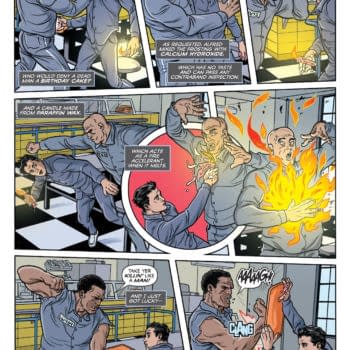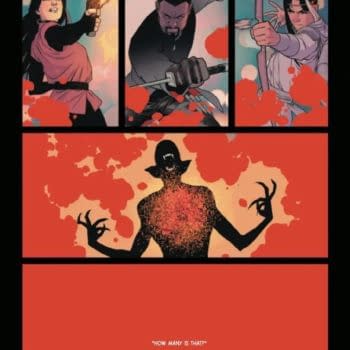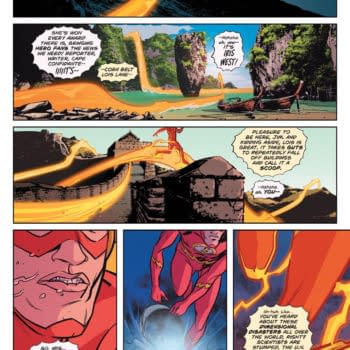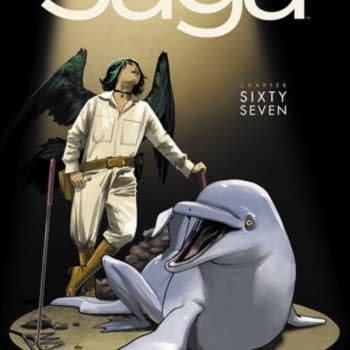Posted in: Comics, Recent Updates | Tagged: All-New X-Men Annual, Ant-Man #1, Batman Annual #3, Comics, dark horse comics, dc comics, entertainment, Grayson Annual #1, Lady Killer #1, Marvel Comics, Operation S.I.N. #1, Unbeatable Squirrel Girl #1, Uncanny X-Men Annual, Wolf Moon #2
Thor's Comic Review Column – Ant-Man #1, Lady Killer #1, Unbeatable Squirrel Girl #1, DC And Marvel Annuals, Wolf Moon #2, Operation S.I.N. #1
This Week's Reviews:
Ant-Man #1
Lady Killer #1
The Unbeatable Squirrel Girl #1
Batman Annual #3
Grayson Annual #1
Uncanny X-Men Annual #1
All-New X-Men Annual #1
Wolf Moon #2
Operation S.I.N. #1
Ant-Man #1 (Marvel Comics, $4.99)
By Devon Sanders (@devonsanders)

Yes, there is a major Marvel motion picture coming out in 2015. I could go into the trials and travails Marvel have had getting this movie to screen but I'll say that if you've gotten this far into the review, you most likely already know about them and if you don't, seriously, take yourself on an Internet safari and learn a lesson in how movies get or just barely get made.
Now, this Ant-Man movie is coming out soon and Marvel, smartly, has brought back perennial also-ran Avenger, sometime Fantastic Four ally and focus of the upcoming Ant-Man movie, Scott Lang with his own new ongoing series, Ant-Man #1.
The elephant in Scott Lang's particular room is that… well, he sort of sucks and series writer Nick Spencer brilliantly addresses this in a first issue that lays out what it means to not be Captain America in the Marvel Universe. More important to this particular story, what it means to possibly not even be the best Ant-Man in the Marvel Universe.
Scott Lang is a man at yet another crossroads. His only teen daughter and fellow superhero, Cassie, is newly returned from the dead. His tenure with the Fantastic Four offshoot, The Future Foundation is done due to circumstances, once again, beyond his control. Child support has to be paid again because you know… child back from the dead and there's also an ex-wife who hates that her only daughter sees dying in battle as part of the family business. Lang calls in a favor, securing an interview with fellow Avenger Tony Stark and it just doesn't go well. Even by Scott Lang standards.
Lang finds himself, again, SOL, falling back into doing the thing that got him into the superhero dance, thieving; if he's going to provide for his family he has to steal from the world's greatest inventor, Tony Stark. With a once in a lifetime shot to turn his life around in his hands, Scott has to make a choice to secure stability for himself or keep faith with the one person who's always believed in him. The choice is at once, heartbreaking and beautiful.
Nick Spencer writes a Scott Lang you simply want to root for. Much like a Don Draper, Lang is a complicated man who truly wants to do what's best but simply just doesn't know what best is. Despite his ability to become small, his heart is a big one and if Ant-Man had a Kryptonite-like weakness, it would be that he tends to lead with it. Spencer knows this and gives the reader a hero whose journey you want to follow.
Artist Ramon Rosanas is a bit of a revelation, bringing a strong clean art style reminiscent of Daredevil artist and designer of Ant-Man's current costume, Chris Samnee. Rosanas' art never asks the reader to guess what's going on in any given panel, it's there to enhance story. Each panel is a wonderful complement to the words on the page and the writer's intent. Trust me, he's someone you're going to be hearing more about.
With Marvel's She-Hulk coming to an end with issue 12, I've been looking for a new superhero book with heart.
2015 is an incredibly young year and in Ant-Man #1, Marvel has given us a comic that not only sets up and introduces us to the star of one of their new potential movie franchises but does what any comic should do and it does it well, it entertains.
Lady Killer #1 (Dark Horse Comics)
By Bart Bishop

Lady Killer #1 follows Josie Schuller, a young housewife with a husband, two daughters, a dog and a live-in mother-in-law, that also happens to be a contract killer. Set in an idyllic early 1960s in the vein of Mad Men, it plays upon familiar imagery with Josie arriving as an Avon girl at a prospective client's house. It turns out, however, that Josie is in an entirely different kind of business than Mrs. Roman expects, with the result being a swift and violent death. This jarringly segues into a chaotic but quaint happy home life, with Josie balancing her wifely and motherly responsibilities while keeping her double life a secret from her family. The only problem is her employer insists she takes a job that Josie is hesitant about, and shows up at her house to force the issue while her husband's suspicious mother keeps a watchful eye.
So why should we care about Josie? Like I mentioned, she spends a third of the issue disguised as an Avon saleswoman and a third of the issue as a dutiful housewife, both roles with costumes and weapons of choice. The only insight into her real personality comes when her contact, Peck, arrives at her front door and they speak in private. This actually functions as a strong thematic device, as it shows that even a secretly powerful woman is still bound by the hegemony. Peck, whose very name is a sexual suggestion, flirts with Josie and she even appears to flirt back, and of course her assignment and the final panel suggest she is as adept using her powers of persuasion with men as she is with Mrs. Roman in the opening, just for very different reasons. Still, I'm most intrigued by the brief moment when she hangs up on Peck: she takes a deep breath, the pressures of her life pushing in, and then calls out, "Dinner's ready!" with a faux cheer that makes one wonder if her home life is refuge from her job, or vice versa?
Unquestionably the art is gorgeous. Jones depicts her characters at lithe praying mantises, hinting at the greater danger underneath. This danger is also prevalent in other little details, like a butcher knife prominent in a frame keeping the reader on edge. She's also a master of costuming, something that is sorely lacking with most mainstream comic books. Characters are too often depicted in generic t-shirts and jeans, but here it's obvious Jones is reveling in the time period, showing Josie as a Jackie O-esque fashionista in the opening and so retro chic in the kitchen as to make Zooey Deschanel proud. She also excels with the pregnant moment, giving the background a living feel that hints at a greater story outside of the foreground plot. Take, for instance, the domestic scenes with the little girls, their Great Dane and the grandma. The girls don't have a line of dialogue, but dressed as Native Americans they're obviously having the time of their lives hounding their dog. Grandma, meanwhile, plays a lonely game of solitaire. Still, instances like Josie checking her bloody skirt and, of course, the Playboy bunny-ish scene on the final page veer too much into cheesecake, with an especial emphasis on cover girl poses.
It's hard to connect just yet because the tone is so heightened as to make the characters almost like caricatures, parodies of the Leaver it to Beaver ideal and horror movie slashers combined. The dark comedy, however, is a lot of fun and the visuals are a treat, so it's worth a look.
Editor and teacher by day, comic book enthusiast by night, Bart has a background in journalism and is not afraid to use it. His first loves were movies and comic books, and although he grew up a Marvel Zombie he's been known to read another company or two. Married and with a kid on the way, he sure hopes this whole writing thing makes him independently wealthy someday. Bart can be reached at bishop@mcwoodpub.com.
The Unbeatable Squirrel Girl #1… And Other Mixed Bizness
By Adam X. Smith
For a long time, I've been rather dismissively referring to the New 52-ified Harley Quinn as being "Deadpool with tits", usually with the implication that that's a bad thing. Admittedly harsh choice of words notwithstanding, I stick by that sentiment – it's a creative decision I still disagree with on general principles and I believe it cheapens the character development Paul Dini and others built up over the course of many years, branching from animation retroactively into comics and spinning off into video games and back into animation again, and with the possible exception of the Injustice spin-off comic, I've yet to read a good Harley-centric comic in the better part of a decade, with the exception of a too-brief appearance in the revamped Batman Black & White #1.
That's not to say that it isn't feasible that one could write a comic that evokes the kind of madcap zaniness that the Merc with the Mouth is best known for with a female protagonist – it'd just be nice if she didn't look like a lamppost in a corset and hot-pants trying to smuggle grapefruit. And, y'know, wasn't a vehicle for toilet humour and ill-advised gags about suicide and self-harm.
Imagine, then, the joy inside my black, cynical little heart when I by chance encountered this week's debut issue of The Unbeatable Squirrel Girl, only to discover that it's a quirky, kooky, refreshingly goofy meringue of a book, a fluffy and sweet confection with just enough crunchy character moments and offbeat chuckles to make it a worthwhile enterprise.

And that's it – that's pretty much the first issue. That might not seem like a mind-blowing debut to most of you, but like so many of Marvel's titles featuring female heroes in prominent roles, it's always reassuring to see them done exceptionally well. And barring the fact that she has an enormous bushy tail and squirrel-like front teeth, Doreen actually looks kind of cute as a slightly chubby, slightly short auburn-haired woman with a squirrel-ears Alice band. Sure, it's an all-ages comic and there's never any real need to sexualise her, but it's just further proof that you can make comics that appeal to a broad audience without making all the women either stick figures or improbably balloon sculptures designed by someone with only a passing understanding of female anatomy.
Ryan North, better known for writing comics based on Adventure Time, leans heavily on the fourth wall, whilst remembering that at the core of Squirrel Girl's appeal is a character who was created (with input from legendary Marvel alum Steve Ditko) in order to provide some much needed levity at a time when Marvel's principle output was grim-dark vigilantism and ponderous costumed soap opera. In collaboration with artists Erica Henderson and Maris Wicks, North comes closest to capturing that can-do, cheerful optimism and everything-including-kitchen-sink mentality towards Marvel's long list of forgotten or neglected heroes since Warren Ellis' last critically acclaimed revamp. Seriously, pick any of them – the analogy works regardless.

So that's one of 2015's new series off to a good start. Let's chalk up some old business from last year.
Since our former comrade Joe has left us and the Society of Superheroes issue left me indifferent, I'd lost the zeal to continue reading Grant Morrison's Multiversity project on an issue-by-issue basis and have only just got round to catching up with the currently released issues. In short: The Just is annoying and vacuous in the same way all articles written by Gen-Xers bitching about Millennials tend to come off – it's just another old person who should know better whingeing about "the kids" having no drive and never really has more than that to say; Pax Americana, the only one of the books I actually wanted to read initially, is technically well executed but never manages to be more than yet another Watchmen rip-off; Thunderworld, as luck would have it, ends up being the only one worth a damn in the whole bunch by virtue of feeling like it could be a genuine Fawcett comic (or Morrison's deconstructed version of one) even without all the Multiverse nonsense peaking round the corner of the frame. I wonder if Grant is as bored of this little experiment as I am, because so far the best he's managed to come up with are two issues of fanservice and a lot of side-story guff that I have zero investment in but is constantly being pushed as the meta of the series. Coming this month: a handy dandy 80 page guidebook featuring a (probably) complete history and map of the Multiverse. And multiple Batmen. Joy of joys.

After I recently wrote an article on the future of Spider-Man on film for Electrolyte, I've been trying to catch up with Miles Morales' tenure as Ultimate Spider-Man with varying levels of difficulty; his comics' semi-frequent renumbering and retitling makes it a nightmare to locate trade paperbacks in anywhere but the most well-stocked and fastidiously alphabetised comic retailers in the UK. As of the eighth issue of his current volume, I've noticed that the slowly unfolding revelations regarding his father's mysterious anti-cape prejudice seems to involve him working with a younger Ultimate Nick Fury to take down the Kingpin. Whilst revelations are sure to come thick and fast for a while, it's intriguing to see Miles' family backstory being filled out now, and being retroactively entangled with the Ultimate universe's greatest heroes and villains, at a time when the cinematic Spider-Man's future is in a quantum state between staying at Sony or reverting to Marvel. Could this be Marvel setting Morales up for easier integration into a post-Peter Parker MCU, much as the Inhumans and Guardians of the Galaxy's profile in the comics rose in anticipation of their on-screen appearances? Time will tell.
Bitch Planet, you had my curiosity, but now you have my attention. Still on the list to catch up with over 2015: The Wake, Sandman Overture, Sex Criminals, Lazarus, and the rest of Kim Newman's Witchfinder miniseries and Miles Morales: Ultimate Spider-Man. Don't judge me.
Adam X. Smith is a paranoid android from the Planet X. For the last 27 years he has been living amongst the people of Birmingham, England (and more recently the University of Lincoln) ostensibly as a student of the school of hard knocks (also BA Hons Drama), but secretly on a mission to scout out the planet for invasion by alien forces; his weekly communiques on his various blogs are actually highly coded messages to his extra-terrestrial masters. He enjoys the musical stylings of local chiptune-metal band Elmo Sexwhistle, the fiction of Kim Newman, Kurt Vonnegut and Chuck Palahniuk, and his hobbies and interests include film-making, drama, occasional Youtubing, journalism and plotting the subjugation of humanity. He can be found on Youtube, Tumblr, Twitter or by jamming an ice-pick through the optic chiasm.
Annual Madness
By Graig Kent
The comic book annual for the Big Two is a strange beast indeed. Initially starting out as a source for reprinting older material, they've morphed all sorts of way in the decades since. They have acted as starting points and finales of story arcs, or once a home for special or important character stories told outside of a series' continuing saga, these typically beefy books have to work double duty: to be enticing enough for the series regular readers to pick up and to hopefully attract new readers to it.. Throughout the 1980's the Annual was a regular and exciting thing. Often they were anthologies, used to put the spotlight on supporting cast members of a regular series, as well as presenting pin-ups from popular artists, Marvel Universe or Who's Who profile updates, and other enticing goodies.
When the 1990's hit, the Annuals were turned into mini-event machines, where a story or theme would run through some or all of a company's yearly books (1993 both DC and Marvel used their annuals as a vehicle to debut new characters, of which only Hitman managed to have any traction at all). The mini-event or thematic ties (like the all "Elseworlds" Annuals of 1994) gave the Annuals their own sense of relevancy and purpose, beyond just being a "side issue" to the regular series. But in the big speculator collapse of the mid-90's the Annuals died a big old death, and have only been scattershot since. DC resurrected the annuals for some of its titles within the New 52, and has been consistently releasing them for the past three years. Marvel likewise has come back around, though in both cases, not nearly in the volume that they once were, when it seemed every ongoing would have their own annual (and some that had no ongoing would get their own).
These latest batch of annuals are a hodgepodge of what they were in the past. Some are side-stories taking place at a different point in the continuity of the regular series, others are backfilling details that the regular series couldn't handle in much depth, while some are just telling a longer one-shot story than could be handled in a normal issue. In the 80's and 90's the Annuals tended to run during the summer months, which were typically bad times to start new series or mini-series, so the Annuals were used to fill out their release roster. These recent annuals come out at any time, whenever they're ready it seems, though a lot were bottom-loaded into December . The Annuals of old were also frequently much thicker (80 or 100 pages weren't uncommon) so they had a lot of extra content or felt extra-epic, while today's annuals are at best double-sized at 40-pages if not only 30 pages. Personally, I would like to see DC and Marvel produce something more akin to the British annuals — Beano and the like — hardcover reprints with some additional material and lots of activities pages and such, out in time for the holidays. They skew a bit younger, but they do feel special, and fun.
Here are a few Annuals from the past few weeks you may have missed, or overlooked.

As a done in one story, taken at face value, it's actually pretty good. James Tynion IV is a top notch writer who has yet to find the right vehicle that will take him to the next level, but he's got the goods…most of the time. He's joined by artist Roge Antonio, whose work is much like Terry Dodson if inked by Kevin Nowlan, really lovely stuff that captures the comedy, the horror and intensity all with equal aplomb. But beyond that surface — the well written, well-illustrated, well-told story — is the story itself. It revolves around Tommy Blackcrow, a hard-boiled journalist who's just returned from a foreign correspondence gig to Gotham City in the early days of Batman and the rise of eccentric criminals. He takes the gig to get the scoop on the Joker, cocksure and fearless, until he comes face to face with his subject. He shoots his mouth off and Joker, in a manner of speaking, imprints upon him, marking him as his best friend. The story then starts jumping forward in time, to each time Joker pays his "BFF" a visit, and the horrible things he does. Through it we see Blackcrow slowly unravel, and we have to question whether Joker genuinely has affection for this man or if he's just psychologically torturing him (or both?). It's a creepy bit of business, but back-inserting this "important" character into the Joker's story, at each monumental turn for the character, just rubbed me the wrong way from the onset, and given where Blackcrow winds up I have a hard time justifying this story's existence or its place in canon.

This issue, written by series writers Tim Seeley and Tom King, is probably the closest the title has come to "hard-espionage" so far, and it's pretty solid. The premise finds Helena Bertinellin in the trunk of an Irish mobsters in Dublin. As the granddaughter of a legendary crime boss, her captor wages that she's pretty valuable property and seeks to sell her to local kingpin St. Francis. Her captor is Dick Grayson, thick in accent and deep in disguise. It's not apparent at first blush and Seeley and King don't spell it out until the end, but they pepper his extraordinary and plentiful dialogue with enough clues that most readers should pick up on it early enough. Regardless, it really does sell how well Dick is at going deep undercover, and how capable he is at improvising and character work. The whole thing is a beautiful con, and even though there's no credible threat to either Dick or Helena, seeing them execute the plan is a quite fantastic ride.
It seems at this stage that Stephen Mooney is the de facto series alternate artist, subbing for Mikel Janin in any Grayson-related one-shots or sides stories (see also Secret Origins #8). Obviously Mooney isn't Janin, but I'm also not sold that he's a good replacement for Janin. By all means he's an incredibly solid storyteller, but his style isn't as clean as Janin's, and his characters aren't pretty or consistently rendered. The underlying sell of Grayson is the same as CW's Arrow: handsome, buff men whose torsos will be bare at some point each outing (Notably, my wife expressed extreme disappointment with Mooney's shirtless Dick rendering in the Futures End one shot). With that in mind, it should be noted that Dick doesn't appear shirtless at all in this Annual (I'm not even sure how they could have shoehorned it in, but they really should have). Despite any meager artistic/sex appeal disappointment, it's still a great read. Seeley and King have really got something special here.
And not to neglect Marvel's Annual output, with the Uncanny X-Men Annual #1 and All-New X-Men Annual #1 (Marvel, $4.99 each) we have a two-parter that fills in some gaps in the ongoing All-New X-Men series (well, a gap, singular).

So, if I'm not a regular reader of Bendis X-books and I'm not familiar with the character of Eva, nor have I any prior awareness of the strange anomaly that occurred to her, why would I be plunking down ten bucks for this two-part story? Simply answered: Andrea Sorrentino.
If you know Sorrentino's work from DC's New 52 book I, Vampire, or more recently his great Green Arrow run with Jeff Lemire, then you have no further questions and you're probably running out to pick up these books now, if you haven't already. If you don't know Sorrentino, well, then you're missing out on one of the most fascinating illustrators in mainstream comics. Where his style started with a heavy Jae Lee influence, Sorrentino has since evolved into his own unparalleled artist, playing with the form of the comics page in a decidedly unique way that rivals JH Williams III but doesn't really borrow from his immensely influential layouts. Beyond his stunning character work, his always fascinating panel structure, and his incredibly engaging storytelling, Sorrentino has also paired himself with colorist Marcelo Maiolo for some time now, and the two have established a near symbiotic relationship, where one feeds the needs of the other. Maiolo drops the story into sepia tones when Eva lands in the old west, and washes out in blue every time Eva uses her powers, but generally the colors surrealy pop from the page. He will accent certain colors in only a single panel with purpose, or likewise flatten out the colors of the background to highlight a character's reaction. Every colorist strives to embellish the art, rare are the colorists that strengthen the story.

So yeah, I may not read the regular series, I may not know the character or have reference to the situation this story is explaining, but I'll be damned if it truly isn't one of the most entertaining reads of 2014. Highly recommended for both Marvel and art fans.
Graig Kent's first novel, Quarter City,can be read for free on Wattpad. Set in alternate universe, the story is framed around society's reactions to beings with super powers, focusing on the extreme actions of the city's most powerful Enhanced in particular. You might like it. Graig tweets stuff @thee_geekent and he does various other things in other places.
Wolf Moon #2 ($3.99,Vertigo)
By D.S. Randlett (@dsrandlett)

By contrast, the Vampire is a monster of civilization, playing the game of society better than anyone else. This is reflected in the stories that we can tell about each of these monsters, especially since the predominant mode of telling scary stories became the cinema. Most modern vampire stories follow something of a model established by Bram Stoker's Dracula, involving seduction and the subversion of institutional morality. Most werewolf movies are about a guy being bitten by a werewolf and the wondering if he's going to become a werewolf, and there are only so many ways that you can spin that, especially in the more linear context of film.
Writer Cullen Bunn has always worn his Stephen King influence on his sleeve, especially in his work where he takes old folkloric horror and recontextualizes it into different genres and times. The Sixth Gun isn't quite a riff on The Dark Tower, but it shares some of its DNA in that weird old folklore tropes are recontextualized to clash with other genre tropes. It can easily be seen that Bunn really likes old stuff: classic horror, westerns, classic film. One of his greatest abilities is taking those influences and putting fresh spins on them while retaining the core elements that made them register in the first place, and that we may have forgotten about since. Think mummies are boring and played out? Not in The Sixth Gun they ain't.
In Wolf Moon, Bunn and artist Jeremy Haun take on werewolf lore, and really succeed in making it fresh. They start in their first issue by showing just how deadly the series' werewolf can be. The creature's blows cause innocents to come apart like something from ED-209's first appearance in RoboCop. This monster is, obviously, not fucking around. And neither is Haun's art in these scenes, as the gore on display is at once disturbing and exhilarating. These scenes are often narrated by the principal character of the series, Dillon (named for the marshal of course), and these scenes really play up the narrative contrast in a way that evokes some classic Incredible Hulk stories: the experience of power and rage is at once freeing and horrifying.
But what makes this story work isn't strictly the werewolf scenes. So much of what revitalizes the werewolf concept is happening while the monster isn't even there. Bunn's script takes current pandemic anxieties (like those recently unleashed during last year's ebola "outbreak") and adds in Navajo skinwalker folklore to significantly change the nature and feel of the werewolf story. While there is still a lot of mystery shrouding the series, Bunn's take on the werewolf centers around the idea of a spirit that hops from person to person through eye contact, and then is only able to assert itself during a full moon, so that we follow not only someone who is a werewolf, but people who have been werewolf, including Wolf Moon's protagonist, a former-werewolf werewolf hunter who feels more like a Philip Marlowe than an Abraham Van Helsing.
It's also worth noting that Wolf Moon compels not just because of it's core take on werewolf-centered horror, but also because of the other genre elements that it's bringing to the table. While the horror is front and center, this is also a noir murder mystery (someone is killing people who have survived their werewolf ordeals), and it bears the greatest hallmarks of the great noir detective stories. A haggard but empathetic protagonist? Check? A set of compelling mysteries? Double check.
While it's still in its infancy, Wolf Moon is quickly becoming a favorite of mine, and I urge fans of Bunn's work or just solid genre storytelling to give it a shot.
D.S. Randlett lives in the hills of Virginia and takes credit for the reviews that his emaciated twin brother writes while chained to the old radiator. He plays his guitar while biding his time for unsuspecting tourists and thinking about going to grad school.
Operation S.I.N. #1 of 5 (Marvel, $3.99)
By Jeb D.
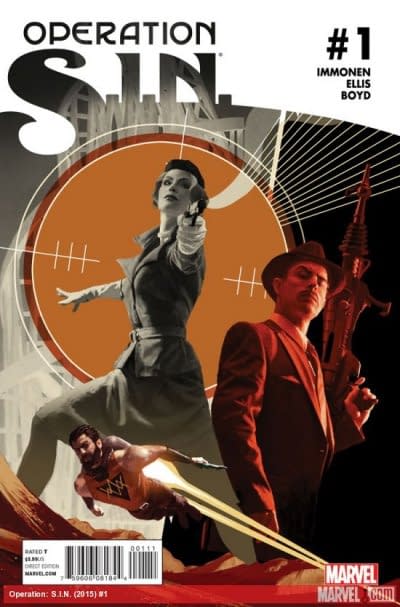
Fortunately, Operation S.I.N. #1 manages to avoid the worst possibilities inherent in both those concerns; that it does so by somewhat limiting the scope of this first issue feels like the right choice: it's the relationship between Peggy Carter and Howard Stark that will carry the book, rather than any overarching MacGuffin hunt, and Immonen nails it. One thing that the Marvel Cinematic Universe has actually done pretty well so far is male-female pairings where romance, if it comes at all, is less important than shared goals and professional camaraderie (see: Thor-Sif, Star-Lord-Gamora, Fitz-Simmons, even Stark-Potts), and in the first Captain America film, Peggy Carter managed to have it both ways, so to speak: if her meet-cute with Steve Rogers eventually blossoms into unconsummated romance, her relationship with Tony Stark's dad has some of the flying sparks of a fast-talking dame from a Howard Hawks film, and those are the aspects that Immonen carries over to the comics.
The setting and backstory for this miniseries are different from the TV show: here, Peggy's not an overlooked functionary seeking a way to make a difference while dealing with sexist jerks, she's a retired action hero, bored with a postwar world that lacks the adrenaline charge of her role fighting the Axis (though I won't be surprised if the odd sexist male is put in his place here and there in the comic, too). Stark's decision to get her juices flowing again by staging an absurd home invasion is a bit of over-the-top comic book silliness that lets us know right away that this series won't be stuck in the dreary, self-important mold of its predecessor/sequel. The plot/MacGuffin hunt is going to involve Woodrow McCord, Fury's predecessor as the "Man on the Wall," but I'm hopeful that the compressed five-issue schedule for the series will keep the focus on Immonen's crackling His Girl Friday-like banter between Peggy's professionally disciplined ex-soldier and Howard's playboy/mad scientist.
The art team of Rich Ellis and colorist Jordan Boyd do a terrific job of balancing exposition, fast-moving action, and period detail, including a well-chosen color palette (more than some creators, they grasp that there's actually a design period that comes between The Rocketeer and Mad Men). The art, though realistic enough, has a lively, cartoony vibe to it, with particularly great facial work on Howard Stark, whose loose-limbed energy and exaggerated facial expressions suggest Cary Grant or Clark Gable at their most animated, and which contrast nicely with the almost military bearing they give Peggy. The only real action sequence in the first issue is the aforementioned "raid" on Peggy's home, but its confident sense of pacing and geography suggest that Ellis and Boyd are ready to cut loose as soon as Immonen sets them to it.
Female writers at the Big 2 tend not to be presumed to be sitting at the grownups' table till they're on a regular spandex monthly, and it seems unfair that Immonen's best stuff is often among Marvel's least-promoted (the solicitation for this book refers to her as a "megawatt" writer, but the only credit it cites is her truncated run on Journey Into Mystery). Hopefully, the tie-in with the TV series will elevate her profile to the point that they keep her as busy as are the Aarons, Hickmans, and Bendises (Bendi?), because the more comics we get with her strong sense of character and fun, the better.
Jeb D's recovering nicely, thanks.










